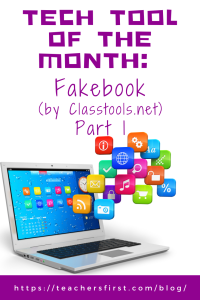Fakebook allows students and teachers to create Fakebook pages (similar in design to Facebook). Profiles can be made about real or fictional people. You can include images, profile photos, friends, posts (that can be dated), and additional information. You can save a project (by creating a password) and return to work on it later, making this an excellent tool for partners to collaborate virtually. You don’t need to register. You can go ahead and download your finished project or share the provided URL when finished.
Applying the Triple E Framework
The Triple E Framework, created by Dr. Liz Kolb, believes that “effective technology integration begins with good instructional strategies and not fancy tools” (tripleeframework.com). Dr. Kolb wrote a book on the topic, Learning First, Technology Second (ISTE, 2017), that lays out the three main uses for technology in education: to Engage, Enhance, or Extend learning goals. We can use this framework to decipher why we use specific classroom tools. Here is a rubric based on the Triple E Framework you can use to evaluate whether Fakebook (or any other technology) is a good fit with your learning goals and whether you should use it in your lesson.
- Engage in learning goals: Fakebook motivates students to begin the learning process by engaging students in social-media-like projects, creating pages similar to Facebook pages. Students also go from passive to active learning as they make the profiles and “become” the person they write about. They can add their own images, words, quotes, videos, and more.
- Enhance learning goals: Fakebook offers students some scaffolding as they create their Fakebook profile. The web tool has arrows to guide students and labels to help find the profile page’s different areas. Fakebook allows students to demonstrate a more sophisticated understanding of the content by creating a realistic-looking Fakebook profile page with details about the individual. Fakebook also creates a path for students to demonstrate their learning in a way they could not do without technology. For example, the Fakebook profiles can include the person’s friend list, video clips, biographical information, conversations between the person and friends, and more.
- Extend learning goals: Dr. Kolb describes extended learning as an opportunity for students to learn, connect, and collaborate outside the regular school day and as a way to create a bridge between school learning and everyday life experiences. Fakebook could be completed as a remote/asynchronous learning activity. Students could share their finished products using the provided web link. Fakebook can also help students prepare for everyday life experiences, as future jobs (or coursework) may require them to use social media to post information to friends or clients.
SAMR Connection
The SAMR Model, by Dr. Ruben Puentedura, suggests that technology implementation has four levels. Therefore, we can use this model as a guideline to analyze how we use technology tools in the classroom. For example, using Fakebook with your students could be at the Substitution, Augmentation, and Modification levels, depending on what the student is doing.
- Substitution: The substitution level is the most basic level of SAMR and refers to when technology acts as a direct substitute without any functional improvements. An easy substitution example is having students upload an image and information to Fakebook and create a profile online rather than planning a profile page on a teacher-created worksheet template.
- Augmentation: At the level of augmentation, the technology acts as a direct substitute and includes some functional improvements. We could take our Fakebook profile page to this level by adding videos, web links, and images. These media options offer many functional improvements compared to using non-technology options.
- Modification: The level of modification allows us to make (or modify) the activity into something more integrated with technology, meaning there is significant task redesign. The Fakebook profile page could be moved to the level of modification by having students share their finished profile pages with the rest of the class using the provided URLs. The Fakebook profile pages could be made into a virtual gallery for the class to view using web tools such as Wakelet (reviewed here) or Padlet (reviewed here).
Please take advantage of Part 2 of the Tech Tool of the Month: Fakebook, where we’ll discuss using the tool and classroom ideas. In the meantime, let us know how you have used Fakebook in your education setting in the comment section below.


